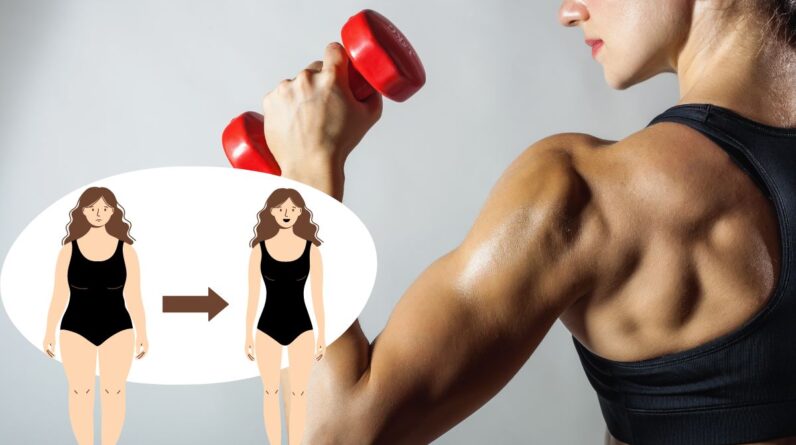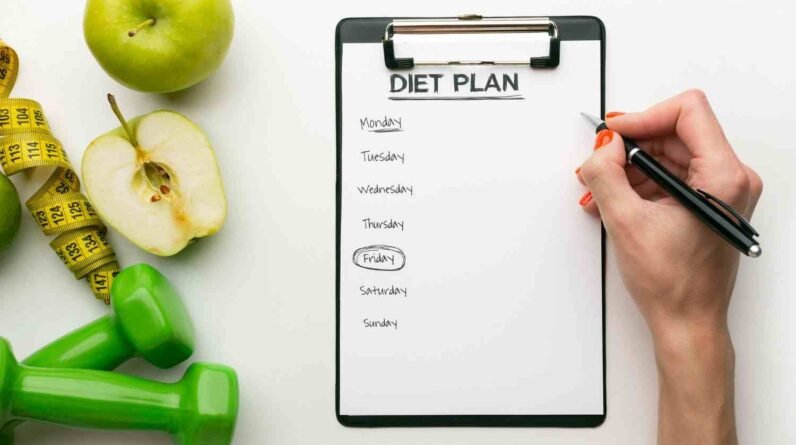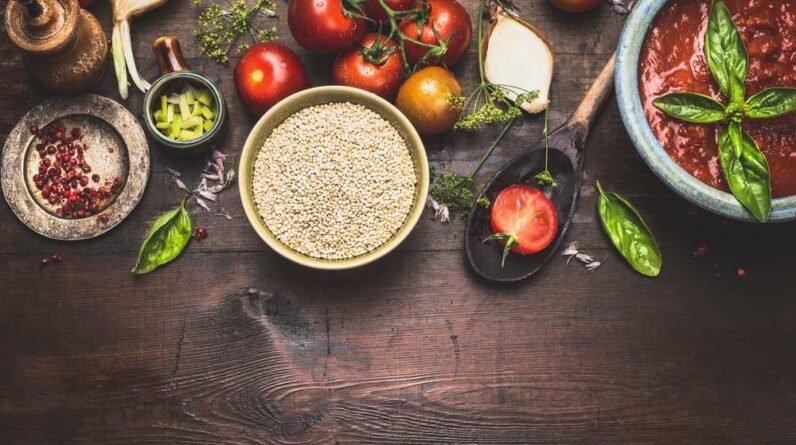
Ever wondered why some people can eat seemingly anything and not gain weight, while others struggle despite their best efforts?
Genetics certainly play a role, but lean muscle mass can make a significant difference for many.
Lean muscle increases your metabolism, helping your body burn more calories even at rest. This makes it easier to maintain a healthy weight and lose those extra pounds.
By boosting your metabolism, lean muscle helps turn your body into a more efficient calorie-burning machine, making it a powerful tool in your weight loss journey.
This post may contain affiliate links, which helps keep this content free. Please read our disclosure for more info.
Understanding Lean Muscle
Lean muscle refers to muscle tissue that is free of fat. This type of muscle is developed through strength training exercises and proper nutrition, both of which are essential components of a healthy lifestyle.
When you engage in activities like weightlifting, bodyweight exercises, and resistance training, you are actively working to build lean muscle.
Unlike body fat, which can slow down your metabolism, lean muscle does the opposite by revving it up. Muscle tissue requires more energy to maintain than fat tissue.
As a result, having more lean muscle increases your metabolic rate, meaning your body burns more calories throughout the day, even when you’re not working out.
This higher metabolic rate can be a significant factor in effective weight management and weight loss.
Lean muscle also improves your overall body composition. Body composition refers to the ratio of fat to non-fat mass in your body.
By increasing lean muscle and reducing body fat, you enhance this ratio, leading to a healthier, more toned appearance. You may notice your clothes fitting better and a more sculpted physique as your body composition improves.
Lean muscle contributes to better physical performance and strength. Everyday activities like lifting groceries, climbing stairs, or playing with your kids become easier and less strenuous.
This increased functional strength enhances your quality of life and helps in preventing injuries and improving joint health.
Lean muscle also plays a crucial role in maintaining bone density, which is especially important as we age. Strength training exercises that build lean muscle also put stress on bones, stimulating them to become stronger and denser. This can help reduce the risk of osteoporosis and fractures later in life.
Understanding the importance of lean muscle and actively working to build it through proper exercise and nutrition can lead to numerous health benefits.
From a higher metabolic rate and improved body composition to increased strength and better bone health, lean muscle is a key component in achieving and maintaining a fit and healthy body.
How Lean Muscle Aids in Weight Loss
The relationship between muscle mass and metabolism is a game-changer for weight loss.
Lean muscle increases your resting metabolic rate (RMR), which is the number of calories your body needs to maintain basic physiological functions while at rest. This means that even while you’re sitting on the couch, your body is burning more calories if you have more muscle mass.
Muscle tissue is metabolically active, which means it requires more energy to maintain than fat tissue. The more lean muscle you have, the higher your RMR.
This is beneficial for weight loss because it allows you to burn more calories throughout the day, even during periods of inactivity.
For example, someone with a higher percentage of lean muscle will burn more calories doing the same activities as someone with less muscle.
Several studies have shown that individuals with higher muscle mass have a significantly higher RMR compared to those with less muscle.
This increased metabolic rate not only helps with weight loss but also makes it easier to maintain a healthy weight over time. When you have more lean muscle, your body becomes more efficient at burning calories, which can lead to a greater caloric deficit and, ultimately, more weight loss.
Lean muscle also has a positive impact on hormone levels that regulate weight and appetite. Strength training, which builds lean muscle, can increase the production of hormones like growth hormone and testosterone, both of which play a role in fat metabolism and muscle growth.
These hormonal changes can help reduce body fat and increase muscle mass, further supporting your weight loss efforts.
Improving insulin sensitivity is another benefit of building lean muscle. Better insulin sensitivity means your body can more effectively regulate blood sugar levels, reducing the risk of insulin resistance and type 2 diabetes.
When your body uses insulin more efficiently, it helps prevent excess fat storage and makes it easier to lose weight.
Lean muscle also enhances physical performance and stamina, allowing you to engage in more intense and prolonged physical activities.
This increased activity level further contributes to calorie burning and weight loss. Activities that were once challenging become more manageable as your strength and endurance improve, encouraging a more active lifestyle.
Building lean muscle isn’t just about immediate calorie burn; it sets the stage for long-term weight management and overall health improvement.
By incorporating strength training into your fitness routine and focusing on muscle-building nutrition, you create a sustainable approach to weight loss that leverages the metabolic and hormonal benefits of lean muscle.
Exercises to Building Lean Muscle
To build lean muscle, strength training is essential. This includes exercises that use resistance, such as weightlifting, bodyweight exercises (like push-ups and squats), and resistance band exercises.
Strength training works by causing small tears in your muscle fibers, which then repair and grow stronger during recovery. This process not only increases muscle mass but also enhances muscle definition and strength.
Here are some effective exercises for building lean muscle:
Squats: Squats target your legs and glutes, making them one of the most comprehensive lower-body exercises. They also engage your core and lower back, providing a full-body workout. Variations like front squats and goblet squats can help keep your routine interesting and target muscles differently.
Deadlifts: Deadlifts work your back, glutes, and hamstrings. They are excellent for building overall body strength because they engage multiple muscle groups simultaneously. Deadlifts also improve your posture and help prevent lower back pain by strengthening the muscles around your spine.
Bench Press: The bench press strengthens your chest, shoulders, and triceps. It’s a staple in many strength training programs because it effectively builds upper body strength. Variations like incline and decline bench press can target different parts of your chest and shoulders.
Pull-Ups: Pull-ups build your back and biceps. They are a great way to develop upper body strength and improve your grip. If traditional pull-ups are too challenging, you can start with assisted pull-ups or use resistance bands to gradually build strength.
Lunges: Lunges target your quads, hamstrings, and glutes. They also improve your balance and coordination. Adding variations like walking lunges or reverse lunges can further challenge your muscles and keep your workouts diverse.
Overhead Press: The overhead press works your shoulders, upper chest, and triceps. It’s excellent for building upper body strength and improving shoulder stability. Dumbbell or barbell presses can be used depending on your preference and equipment availability.
Planks: Planks are a great exercise for building core strength. They engage your abs, back, and shoulders, providing a full-body workout. Variations like side planks and plank twists can target different areas of your core.
Rows: Rows target your back, shoulders, and arms. They help improve posture by strengthening the muscles of the upper back. Bent-over rows, cable rows, and dumbbell rows are all effective variations.
Consistency is key. To see progress, aim to gradually increase the weight or resistance you use. This is known as progressive overload, and it’s essential for continuously challenging your muscles and promoting growth. Start with a weight you can lift comfortably for 8-12 repetitions, and gradually increase the weight as your strength improves.
It’s also important to vary your workouts to prevent plateaus and keep your muscles guessing. Incorporate different exercises, rep ranges, and training techniques like supersets and drop sets to continually challenge your body.
Nutrition for Lean Muscle and Weight Loss
Proper nutrition is essential for building lean muscle and promoting weight loss. The right balance of macronutrients (protein, carbohydrates, and fats) and adequate hydration are key components of an effective nutrition plan.
Protein: Protein is crucial for muscle building and repair. When you engage in strength training, your muscles undergo small tears that need to be repaired.
Protein provides the amino acids necessary for this repair process, leading to muscle growth. Including high-protein foods in your diet helps ensure you get enough of these essential building blocks. Some excellent sources of protein include:
- Chicken: A lean source of protein that can be prepared in various ways to keep meals interesting.
- Fish: Rich in protein and omega-3 fatty acids, which support muscle health and reduce inflammation.
- Beans and legumes: Great plant-based protein sources that also provide fiber, which aids in digestion and keeps you feeling full.
- Eggs: High in protein and other essential nutrients like vitamins B12 and D.
- Greek yogurt: Offers a high protein content along with probiotics that support gut health.
Prioritize protein and include a source of protein in every meal to support continuous muscle repair and growth.
Carbohydrates: Carbohydrates are the body’s primary energy source, particularly during high-intensity workouts. Consuming enough carbohydrates ensures you have the energy to perform well during your training sessions and aids in recovery.
Complex carbohydrates like whole grains, fruits, vegetables, and legumes provide sustained energy and are packed with essential vitamins and minerals. Examples of good carbohydrate sources include:
- Oats: A slow-digesting carbohydrate that provides long-lasting energy.
- Brown rice and quinoa: Whole grains that offer fiber and protein along with carbohydrates.
- Sweet potatoes: Rich in vitamins and provide complex carbs for steady energy.
- Fruits: Offer natural sugars and fiber, as well as essential nutrients like vitamins and antioxidants.
Fats: Healthy fats are essential for hormone production, including hormones that are important for muscle growth and recovery. They also provide a concentrated energy source and support overall health. Include sources of healthy fats such as:
- Avocados: Packed with monounsaturated fats and fiber.
- Nuts and seeds: Provide healthy fats, protein, and fiber.
- Olive oil: Rich in monounsaturated fats and can be used in cooking or as a salad dressing.
- Fatty fish: Such as salmon and mackerel, which offer omega-3 fatty acids.
Hydration: Hydration plays a critical role in muscle function and recovery. Water helps transport nutrients to your muscles and remove waste products from the body.
Staying well-hydrated ensures your muscles can recover properly and function efficiently during workouts.
Drink plenty of water throughout the day, especially before, during, and after exercise. You can also include hydrating foods like fruits and vegetables, which have high water content.
Balanced Diet: A balanced diet that includes a good mix of protein, carbohydrates, and fats is crucial for overall health and optimal muscle growth.
Each macronutrient plays a specific role in supporting your fitness goals. Here’s a sample breakdown of how you might structure your meals:
- Breakfast: Greek yogurt with berries and a sprinkle of nuts, plus a slice of whole-grain toast.
- Lunch: Grilled chicken salad with a variety of vegetables, quinoa, and a drizzle of olive oil.
- Snack: Apple slices with almond butter or a protein smoothie.
- Dinner: Baked salmon with a side of roasted sweet potatoes and steamed broccoli.
- Snack: Cottage cheese with a handful of mixed berries.
Supplementation: While a well-rounded diet should provide most of the nutrients you need, some people may benefit from supplements, especially if they have dietary restrictions or higher protein needs.
Common supplements for muscle growth and recovery include protein powders (whey, casein, or plant-based), branched-chain amino acids (BCAAs), and omega-3 fatty acids.
Incorporating these nutrition principles into your daily routine will support lean muscle growth and aid in weight loss.
Proper nutrition not only fuels your workouts but also ensures your body has the necessary resources to build and repair muscle effectively.
Combining Cardio with Strength Training
While strength training builds muscle, cardio helps burn fat. Combining the two can enhance your overall fitness and speed up weight loss.
High-Intensity Interval Training (HIIT), running, and cycling are excellent cardio workouts that pair well with strength training. This combination not only burns more calories but also improves heart health and endurance.
Myths and Misconceptions
There are several myths about muscle building and weight loss, especially when it comes to women. These misconceptions can discourage women from engaging in strength training and achieving their fitness goals. Let’s debunk some of these myths:
Myth 1: Lifting Weights Will Make You Bulky
One of the most pervasive myths is that lifting weights will make women bulky and give them a masculine appearance.
This misconception often stems from images of bodybuilders who have undergone specific training and diet regimens to achieve significant muscle mass.
In reality, building large amounts of muscle requires years of intense training, strict dieting, and often genetic predispositions.
Women generally have lower levels of testosterone, a hormone crucial for muscle growth, making it much harder for them to gain muscle mass to the extent that men do.
For most women, strength training leads to a toned and lean physique, not bulkiness. It helps in sculpting the body, enhancing muscle definition, and improving overall strength.
Women who lift weights can expect to see a reduction in body fat, an increase in muscle tone, and a boost in metabolism, all contributing to a leaner, more defined appearance.
Myth 2: Avoid Carbs to Lose Weight
Another common myth is that you should avoid carbohydrates to lose weight. While it’s true that some people have success with low-carb diets, carbohydrates are essential for energy, especially when you’re working out regularly.
Carbs fuel your workouts, allowing you to perform at your best and recover effectively. They are particularly important for high-intensity exercises like weightlifting and cardio.
Instead of avoiding carbs altogether, focus on consuming complex carbohydrates that provide sustained energy and are packed with nutrients.
Whole grains, fruits, vegetables, and legumes are excellent sources of complex carbs that support your fitness goals without causing weight gain.
Myth 3: Cardio is the Only Way to Lose Weight
Many women believe that cardio is the only effective way to lose weight. While cardio exercises like running, cycling, and aerobics are great for burning calories and improving cardiovascular health, they are not the only path to weight loss.
Strength training is equally important, as it builds lean muscle, which increases your resting metabolic rate and helps you burn more calories throughout the day.
A balanced workout routine that includes both cardio and strength training is the most effective way to achieve and maintain a healthy weight.
Strength training not only aids in weight loss but also improves muscle tone, bone density, and overall strength.
Myth 4: Women Should Use Light Weights and High Reps
Another misconception is that women should only use light weights and high repetitions to avoid getting bulky.
While light weights and high reps can be beneficial for endurance and toning, lifting heavier weights with fewer repetitions is crucial for building strength and lean muscle mass.
Using heavier weights challenges your muscles, leading to greater strength gains and more pronounced muscle definition.
Women shouldn’t be afraid to lift heavy and push their limits in the gym. Incorporating a variety of weights and rep ranges into your routine can help you achieve a balanced, strong, and toned physique.
Myth 5: You Can Spot Reduce Fat
Spot reduction is the idea that you can lose fat from specific areas of your body by targeting them with certain exercises.
For example, doing countless crunches to get rid of belly fat. Unfortunately, this is a myth. Fat loss occurs evenly across the body, and you cannot control which areas lose fat first.
The most effective way to reduce body fat is through a combination of strength training, cardio, and a healthy diet.
Building lean muscle through strength training can help create a more toned appearance in specific areas, but overall fat loss will come from a consistent, well-rounded fitness and nutrition plan.
Myth 6: Women Don’t Need Protein Supplements
Some women believe that protein supplements are only for men or bodybuilders. However, protein is essential for muscle repair and growth for everyone, regardless of gender.
Women who engage in regular strength training may benefit from protein supplements to meet their daily protein needs and support muscle recovery.
Protein shakes, bars, and other supplements can be convenient ways to ensure you’re getting enough protein in your diet.
Myth 7: Strength Training is Dangerous for Women
Concerns about injury can deter some women from strength training. While any exercise carries a risk of injury, strength training is safe and beneficial when done correctly.
Using proper form, starting with appropriate weights, and gradually increasing the intensity of your workouts can minimize the risk of injury.
Strength training also helps improve joint stability and bone density, reducing the risk of osteoporosis and fractures in the long run.
By debunking these myths, women can feel more confident and informed about incorporating strength training into their fitness routines.
Embracing strength training can lead to numerous benefits, including improved body composition, increased strength, enhanced metabolism, and better overall health.
Practical Tips for Success
Achieving your fitness goals and building lean muscle requires a combination of effective strategies and consistent effort. Here are some practical tips to help you succeed:
Integrate Strength Training: Start with two to three strength training sessions per week. These can include exercises like squats, deadlifts, bench presses, and pull-ups. Begin with manageable weights and gradually increase the weight and intensity as you progress.
Stay Consistent: Create a workout schedule that fits your lifestyle and stick to it. Consistency is key to seeing results. Regularly challenge your muscles by increasing the weight, number of repetitions, or trying new exercises.
Track Progress: Keep a workout journal or use fitness apps to monitor your progress. Record exercises, weights, sets, and repetitions. Tracking your progress helps you stay motivated and provides a clear picture of your improvements over time.
Prioritize Rest: Ensure you get enough sleep and rest days to allow muscle recovery and growth. Aim for 7-9 hours of sleep per night and schedule at least one or two rest days per week. Light activities like walking or yoga on rest days can promote recovery without overtaxing your muscles.
By following these practical tips, you can build lean muscle, enhance your strength, and achieve your fitness goals. Consistency, proper nutrition, and adequate rest are essential for a successful strength training program..
Unleash the Power of Lean Muscle for Weight Loss
Lean muscle is essential for effective and sustainable weight loss. By incorporating strength training, proper nutrition, and a mix of cardio workouts, you can boost your metabolism, burn more calories, and achieve your weight loss goals.
Ready to kickstart your weight loss journey? The 21-Day Fat Loss Challenge offers an at-home workout plan that’s perfect for building lean muscle and shedding pounds.
This program includes a comprehensive guide to strength training and nutrition, ensuring you have all the tools you need to succeed.
Start today, and you’ll soon see the powerful impact lean muscle can have on your journey to a healthier, fitter you. With dedication and the right approach, you can transform your body and achieve lasting weight loss.







